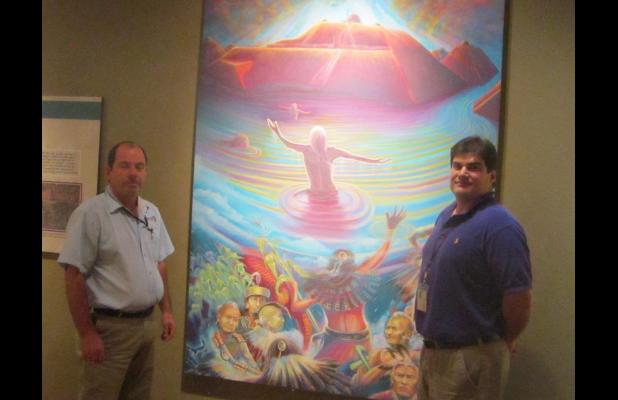Tunica-Biloxi Museum: A tribe’s history
Sat, 07/11/2015 - 05:00
AvoyellesToday.com
Discover Avoyelles
{Editor’s Note: “Discover Avoyelles” is a series of articles about attractions in Avoyelles that could be a short, day activity for families this summer. This installment features the Tunica-Biloxi Museum in Marksville.}
By RAYMOND L. DAYE
It is an important repository of two tribes’ history, but the Tunica-Biloxi Museum is much more than that. It is an important link to the history of this region and one of Avoyelles’ most significant tourist attractions.
At $5 for adults, $4 for senior citizens and visitors with military ID, $3 for children aged 9-12 and free for younger children, it is also an inexpensive day trip -- especially for those who live only a few miles from its doors.
Located in the tribe’s Cultural & Educational Resources Center (CERC), the museum exhibits take the visitor from the “creation” of the tribal people, in a colorful painting, through their history, as told in narrative exhibits along the walls.
Visitors will also get a glimpse at that laboratory where the “Tunica Treasure” is stored and a look at the preservation process. Brent Barbry Sr., director of the lab, explains the importance of the work as well as the process involved.
Earl Barbry Jr. is director of the CERC and the tribe’s Office of Cultural & Historic Preservation. He takes the responsibility to preserve the tribe’s history, culture and traditions very seriously -- but he also says it is just as important that the museum and the center be a useful resource for the community.
“My father always stressed tribe and community in equal measures,” Barbry said, referring to the late Tribal Chairman Earl Barbry Sr. “In that spirit, I can say that this is not only a tribal museum, but a community facility. It is a $13 million investment in this community.”
In addition to housing the museum and lab, the two-story 40,000-square-foot CERC serves as a tribal administration building with 17 offices, two meeting rooms and two conference rooms. It also has a 75-seat auditorium, a library and a distance learning center where classes from Northwestern State University are taught.
Barbry said the center is used for students to attend class while instructors are connected by television, but it is usually used for administering tests in the courses. Most of the course work is done online these days.
The museum allows visitors to see a portion of the artifacts uncovered during archaeological excavations in the Angola and Trudeau area of East Feliciana Parish by amateur archaeologist Leonard Charrier.
The tribe’s efforts to reclaim the burial items, called the Tunica Treasure, was a key case in creating the Native American Graves Protection and Repatriation Act, which states that grave goods belong to the descendants of those whose graves were disturbed.
The pottery shows the craftsmanship of the tribe in the time just after Europeans arrived. Glass beads, brass pots and other items were received by trading with the Europeans, which reflects the tribe’s interest in business even in that time.
Brent Barbry said he is still working to preserve pottery and metals recovered in the Tunica Treasure case. About 95 percent have been properly preserved and cataloged.
“The ‘treasure’ is cultural, not monetary,” Earl Barbry said. “It means a lot to us, but there are no precious metals or items like that.”
The quantity and variety of mid-17th Century European trade goods found at the Trudeau Plantation grave sites was unparalleled in the Southeast region.
“Earl Jr.” said the museum is primarily a showcase for the artifacts and to relate the history of the Tunica and the Biloxi tribes. However, he said the museum is also a significant resource for all Southeast Native American tribes. He hopes to receive more items from other tribes to incorporate into the museum exhibits.
“You hear a lot about the the Western tribes (Apache, Comanche, etc.) and the Plains (Sioux, Cheyenne, etc.) tribes,” Barbry said, “but less about the Southeast tribes. We want this museum to be able to show the history of Native Americans in this region.”
Three women from Sulphur came in for a tour during the interview. Pat Breaux said she had been waiting for the museum to open for many years, since it was planned to replace the original museum building. The CERC opened in 2011.
“I was watching this center grow, but this is the first chance I’ve had to get back since it opened,” she said.
Her friends, Barbara Alleman and Jean Dean, were making their first trip to Marksville but were anxiously awaiting the tour.
“I’m sure I’m going to learn something,” Ms. Alleman said with a smile.
Ms. Dean said she was looking forward to “a history lesson.”

